
Michelle Salamon, Associate Lecturer, BA (Hons) Graphic Communication Design, Central Saint Martins
This article examines the development and running of a pilot scheme called ‘Drawing Laboratory’, a series of 5 workshops devised at Central Saint Martins in 2015, to explore associations between the physical act of drawing, and the encoding and retrieval processes of human memory. The project informally piloted a co-curricular space where drawing extends beyond traditional expectations and is used as a research tool for developing thinking, improving concentration and enhancing memory. The workshops aimed to identify a series of mnemonic devices to record and recall information from episodic memory and use them to develop a tool for use in Art and Design learning environments.
drawing; memory; Drawing Laboratory
This report evaluates the effectiveness of ‘Drawing Laboratory’ a series of 5 workshops devised within the BA Graphic Communication programme (BAGCD) at Central Saint Martins (CSM), one of the six colleges of University of the Arts London (UAL). The workshops (which ran in 2015) explored the relationship between the physical act of drawing and the making and storage of experiential memory. The intention of the project was to informally pilot a co-curricular space in which drawing might extend beyond traditional expectations. It aimed to use drawing as a research tool for developing thinking, improving concentration and enhancing memory. At the time of development, drawing was offered on an elective basis within specified pathways: it was not included within curriculum on the BAGCD programme. Over the course of 6 weeks, a group of 20 volunteer students from various year groups worked together regularly for up to 3 hours at a time.
Initial interest in the relationship between drawing and memory stemmed from a booklet originally published in 1848, on The Training of the Memory in Art by Horace Lecoq de Boisbaudran, a nineteenth century Art professor who developed techniques for teaching drawing through memory (de Boisbaudran, 2011). These teachings provided a springboard for this pilot project, which explored how the creation of drawn images can express and document the act of remembering. It examined whether drawing as an innate human ability can be employed to make sense of memory.
The project was undertaken as action research, accumulating evidence in order to define the problem more sharply (Corey, 1954). The purpose of this research project was to construct a case for recognition of the value of drawing as a learning tool, whilst ensuring the learner’s experience fostered critical reflectivity.
The initial plan aimed to develop a series of 5 workshops, exploring the connections between drawing and memory. It was initially proposed to the BAGCD Programme Director in February 2015 and implemented under the BAGCD co-curricular enrichment programme. A core group of around 20 students were recruited to participate in 5 workshops. Each session concentrated on individual drawing-related tasks, which were explored in relation to a specific aspect of memory.
A blog - Drawing Lab (2015) - was set up as a means of gathering and sharing research, and to enable continuous evaluation throughout the project. Participants were asked to reflect on their learning experiences and complete evaluative feedback forms at the end of each session. This article is an evaluation of the project after completion of one cycle of workshops.
‘Drawing Lab’ proposed that drawing as a concentrated activity could emphasize students’ ability to recall past experience, by developing enhanced connections between hand and eye they would find a greater level of ‘connectivity between experience and information stored in memory. The workshops were designed to focus on drawing as a tool to enhance ‘encoding’, which is how we change information or experience in order to make it storeable through visual, auditory or semantic means. By presenting an opportunity to draw with others, outside usual curriculum constraints and assessment criteria, the project aimed to enrich the student experience.
Since the times of de Boisbaudran (mid-nineteenth century), drawing has been considered a vital technical skill, essential to the role of the artist whose work predominantly centres on observations. Today, drawing is not necessarily included in the art and design curriculum. It is often presented to students as a voluntary pursuit. Few UK Art and Design departments offer degree courses in ‘drawing’. In contemporary art and design education the role of drawing has become viewed as less essential. After using drawing to help him recover from a stroke, broadcaster Andrew Marr described the lack of teaching in this area as ‘a betrayal of students not to teach them the basic skills of their trade’ (in Lydall, 2013). In 2003 Jim Elkins wrote a letter to John Berger, in which he describes drawing as a ‘Ghost Subject’, saying ‘once drawing was indispensable to art itself… the foundation of whatever could be taught…[it now] exists in a limbo’ (Elkins in Berger, 2012, p.106).
Drawing Lab was intended as a space that would be regularly available for staff and students, acting as a platform for the enhancement and development of memory skills, and enabling higher levels of thinking and concentration. The overarching purpose was to enhance the quality of their holistic learning experience.
The opening line of John Berger’s On Drawing is written in capital letters: ‘FOR THE ARTIST DRAWING IS DISCOVERY.’ (Berger, 2012, p.3). Berger argues that drawing is an efficient tool for enhancing experience, especially when viewed as ‘an autobiographical record of one’s discovery of an event- seen, remembered or imagined’ (ibid).
The relationship between observation and movement in drawing, led this project to consider whether the physicality of drawing, as sensory information, might serve as an efficient mnemonic tool. Tim Ingold describes ‘the intimate coupling of the movement of the observer's attention with currents of activity in the environment. To observe is not so much to see what is “out there” as to watch what is going on. Its aim is thus not to represent the observed but to participate with it in the same generative movement’ (Ingold, 2011, p.223). The purposes of drawing are broad and in the context of creative education, often highly individual, ‘private work related only to the artist’s needs’ (Berger, 2012, p.4). This project set out to demonstrate another function of drawing, as a scientific, forensic tool used for probing and searching for answers.
Drawing also acts as a way to approach complex attitudes towards our memories. ‘Emotional arousal and personal involvement in an event seem to be two factors that have a large impact on the likelihood that a vivid memory can be maintained over time’ (Holland and Kensinger, 2010, p.11). Drawing is essentially a personal activity that can invoke emotional arousal. The act of making a drawing to document an event or experience can help maintain a vivid memory of the experience itself.
Berger observes that drawing creates a relationship between an object and the eye: it is filtered through the artist’s mind’s-eye (Berger, 2010, p.3). Through this ability to enable the artist to re-discover their past, drawing might be used as a means to explore some problems of memory, and potentially, improve recall. This is supported by a series of psychological experiments carried out by Wammes, Meade and Fernandes, which found that drawing pictures of information that needed to be remembered was a ‘strong and reliable strategy to enhance memory’ (2016, p.1773). Their intention was to show ‘that drawing improves memory by encouraging a seamless integration of semantic, visual, and motor aspects of a memory trace’ (ibid).
Primo Levi observed that it ‘is certain that practice (in this case, frequent re-evocation) keeps memories fresh and alive in the same manner in which a muscle that is often used remains efficient’ (Levi, 1989, p.11). The muscle memory created by the act of drawing becomes physical, the drawing itself becomes an output, yet the making process leaves a mental imprint. The experience of making a drawing becomes part of the experience of remembering and so, combines the act of remembering with the raw memory.
The subject of memory is discussed here from the perspective of a visual artist or designer. In the context of his nineteenth century research and practice, de Boisbaudran describes memory as ‘stored observation’ (de Boisbaudran, 2011, p.3). To illustrate the contextual basis for this project it is necessary to explore some simplified scientific definitions and terms that underpinned the design of the workshops. For example, Hermann Ebbinghaus’ ‘forgetting curve’ is a diagram that describes how information decays and is forgotten over time, it notes that immediately after an event we have 100% retention of the memory, but after as little as 20 minutes of elapsed time, the ability to retain information is reduced to 58%. (Stahl et al, 2010).
Psychologists describe ‘encoding’, ‘storage’ and ‘retrieval’ as the three main functions in the formation and retrieval of memory. There are various ways of encoding information. Visual, spatial, auditory, and olfactory mechanisms present triggers or stimuli that assist in people revisiting and re-examining their experiences which are referred to as ‘retrieval cues’ (Tulving and Thomson, 1973, p.391).
As previously mentioned, the emotional content of an experience can influence the way in which an event is remembered. When discussing the retrieval of stored memories, Holland and Kensinger examined the interaction between ‘emotion and autobiographical memory’ (2010, p.2). They explored how the emotional content of an experience can influence the way in which the event is retained and recalled. ‘Episodic memory’, is used to refer to more personal memories, such as the sensations, emotions and personal associations of a particular place or time. It describes when a person can memorise information, using objects, places, animals or people to create a mental image. ‘Autobiographical memory’ describes the memory of particular events within one's own life. It is generally viewed as either equivalent to, or a subset of, episodic memory (Holland and Kensinger, 2010, p.3).
Human memory is a marvellous but fallacious instrument. The memories which lie within us are not carved in stone; not only do they tend to become erased as the years go by, but often they change, or even increase by incorporating extraneous features.
(Levi, 1989, p.10).
Human memory is vulnerable and prone to the effects of external influences. It is liable to forget. ‘Explicit memory’ is used to recall events from the past. These memories are not carved in stone but become more difficult to recall due to distortion over time. In order to ensure the efficient and continuous storage of a lifetime of information, it is necessary for the human brain to compress memory material. Recent technological developments have significantly changed the ways humans encode memories. Many millennial students (and tutors) have grown up using external aids or devices for remembering and storing details about their lives. The project considered this impact upon memory encoding and retrieval skills, examining approaches to enhancing human memory and the storage and retention of data in our minds.
Current inclinations and habits to regularly record even the most mundane aspects of our lives, can reinforce the belief that it is possible to constantly revisit the past. Yet, these resources may in fact stand as a barrier between the event and our physical experience of it. The photo album, the home movie and social media have influenced our experience of memory, and it is through these formats that we retain and record our lives.
Examination of stored memories raises questions about whether the storage process affects memories and whether there is a degrading or erosion effect that increases in relation to the length of time a memory is kept. Formats such as photography and film can efficiently record and document events, however physical visualisation techniques such as drawing can employ stylistic techniques with the potential to clarify focus, draw emphasis and explore the extraneous features to which Levi refers. It is blemishes and stains that make human memory unique and individual. The perceived quality of experience in encoding, memory storage and retrieval has provided an important foundation for the development of workshops within the Drawing Lab.
Pedagogic research indicates the benefits of physical activity for learning. For example, Alan Baddeley uses the term ‘visuospatial sketchpad’ to describe a mnemonic mechanism for enabling recall (2000, p.2). The sketchpad within the mind performs the function of holding visuospatial information and can be broken down into separate visual, spatial and possibly kinesthetic components. These components relate to the concept of kinesthetic learning, where learning takes place by students carrying out physical activities, rather than passively listening to a lecture or watching demonstrations (Leite et al, 2010, p.323–339). Drawing Lab set out to focus on drawing as a physical activity with the aim of improving recall. As part of this process, students examined and recorded their own self-developed mnemonic systems and reflected on how repetition and concentration affected recall. The physical act of drawing was used to transfer information from abstract experience onto a physical sketchbook, whilst also storing the experience in memory.
Since the laboratory was situated in a design focussed higher education environment, it is important to consider the relevance of visualisation as a learning tool, and to acknowledge the value of diagrams and other forms of visualisation to the act of learning itself. Barbara Tversky describes the virtues of such modes of visual communication: depictions ‘have other impressive advantages over words in addition to being readily recognized: They access meaning faster (Smith and Magee,1980) and enjoy greater distinctiveness and memorability’ (Tversky, 2011, p.516). The act of creating visualisations might be referred to as drawing regardless of the discipline.
On the BAGCD course, design students are encouraged to investigate and analyse ideas in sketchbooks, commonly using drawing or diagrams. The Drawing Lab provided a channel through which to consider drawing as both a problem-solving tool as well as a way of enhancing concentration. Students used sketches to discuss and explore their own individual experiences of remembering. Tversky describes how for designers, sketches are ‘intentionally ambiguous’, going on to observe that ambiguity ‘can help designers innovate and escape fixation by allowing perceptual reorganization and consequent new insights, a pair of processes, one perceptual, finding new figures and relations, and one conceptual, finding new interpretations, termed ‘constructive perception’’ (Tversky, 2011, p.523).
The Drawing Lab workshops employed a series of exercises designed to encourage students to approach drawing from new perspectives that enabled them to explore ways to escape fixation and find new ways of interpreting experience. BAGCD encourages students to approach problem solving using design thinking, continually examining how this concept is interpreted. From Nigel Cross, this term addresses the value of drawing as a tool for problem solving within design. Design thinkers produce:
…novel unexpected solutions, tolerate uncertainty, work with incomplete information, apply imagination and constructive forethought to practical problems and use drawings and other modelling media as a means of problem solving.
(Cross, 1990, p.6).
Techniques that enable memory recall became a prime area of interest during the project. It was felt that different approaches to recall (mnemonic systems) might provide insights into the relationship between the act of drawing and memory encoding and storage. Drawing Lab recorded what was learned and obtained data about individual processes of encoding, retrieval and compression through evaluative feedback data. A series of five Drawing Lab workshops each three hours in duration, ran weekly from May to June 2015. Feedback questionnaires were created specifically for each workshop. During each workshop students were asked to put away mobile devices.
This session examined the transfer of short term to autobiographical memories. The workshop required participants to create visual evidence of their ability to encode and store information in memory. Each participant was given a different object to concentrate on, and asked to observe and draw it from 8 angles using a template grid. By creating a drawing from each perspective, they were able to analyse and record the object and cumulatively store the information in their memory. After completing 8 rotations the object was removed and as a “blind test” redrawn from memory. This process was based on de Boisbaudran’s nineteenth century workshops, which enhanced object knowledge by engaging a deep level of concentration through repeated drawing, recording a subject into memory in order to then visualize it from memory, in its absence.

Feedback forms focused on participant’s description of the recall systems developed during the exercise. Techniques for remembering the object included: analyzing structure; using the eyes like a scanner; using the paper template grid; symmetry; and association with familiar objects. Students reported improved knowledge of the subject. Through repetition they were all able to draw the item accurately after one hour of repeated exercises, and reported that the process of re-drawing was helpful during the blind test. One student described the object as ‘imprinted on my memory’.
The second workshop examined the ability to gather and recall information about a ‘remote target’, a life model located behind a screen, hidden from the viewer and separated by some distance. Students were given 1 minute to view the pose and then returned to their drawing space, gradually compiling drawings from short-term memory recall. This workshop required them to devise specific information storage techniques. After completing the drawing, participants were asked to write a paragraph of text documenting the techniques they used for recall.
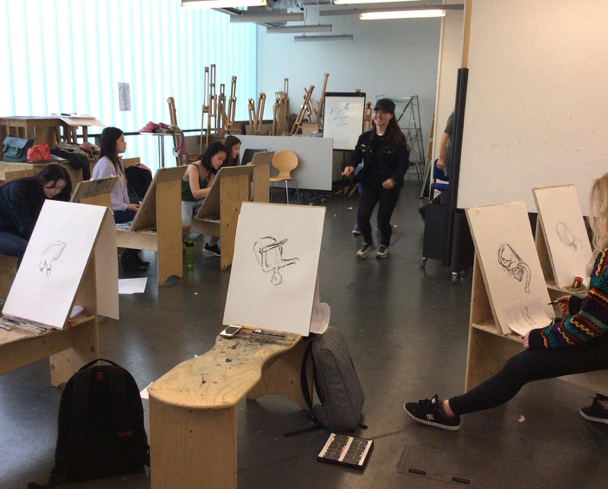
Students reported a notable depletion of recollection in the time spent walking back to easels, which took approximately 20 seconds. One student stated that ‘memory seems to start fading from the second my eyes left the model… in those few seconds walking back to my seat the pose has already become blurry’. Another student described it as similar to carrying water or sand in their hands. The human form is complex and difficult to draw. This, combined with the need to recall a pose and the added attributes of perspective and proportion made it a very difficult challenging exercise. Student feedback outlined that recall improved where the form was simplified into a series of basic geometric shapes. One student described how she tried “air drawing” or rehearsing the drawing in air as a form of muscle memory, in order to recall the movement of her arms.
For the third workshop, the intention was to generate a group memory.
Students documented a series of events, drawn in different locations, and examined the suggestive effects of working in a group at the time of making the drawings. They were asked to create a narrative of the location to be recalled and redrawn the following week in the studio (away from the original location). The students were separated into 4 groups of 4. Each group was assigned a bench located around St Pancras Station, where they were seated in a row. The groups identified a common horizon line, such as the floor level, ensuring that it matched across all their four drawings. Individuals drew a section of the view in front of them, which when viewed side-by-side formed a panorama. This format allowed the students to focus on a larger space as a group, combining concentrated elements from individual drawings to depict a group experience and form a group memory.
To test recall and the suggestive effects of others, the groups were separated the following week and students were asked to produce one drawing alone, followed by another when reunited with their group. Several of these drawings took the form of motion sequences which students felt better summed up the time-based experience of the original process. The recording of sensory experiences such as smells from nearby restaurants, or sounds of children playing, proved effective as retrieval cues. Feedback sheets recorded sensory information relating to the immediate environment. Since the experiences were encoded communally it seemed likely that at the time of recall, retrieval cues from one individual’s memories could trigger recollection or suggestion in other group members.
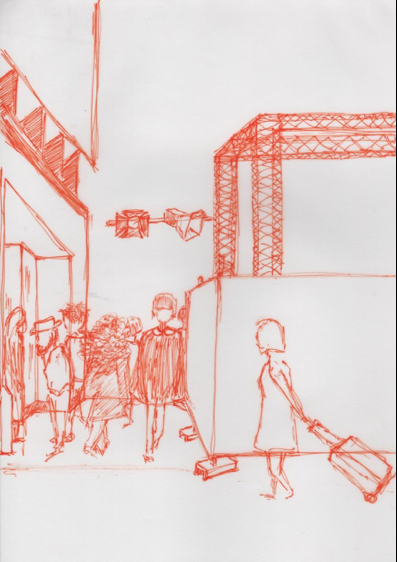
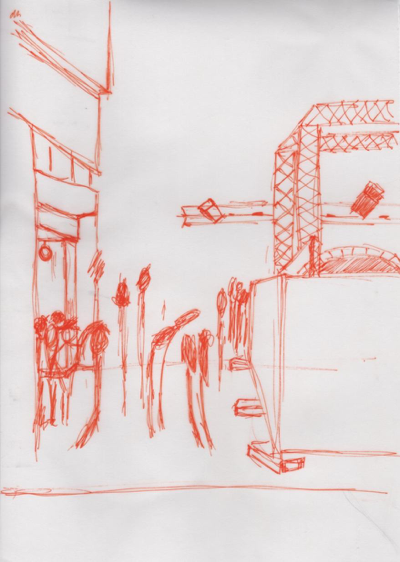
For this workshop, students were asked to recall personal episodic information, specifically childhood memories relating to their first pair of shoes. They were asked to give form to personal items.
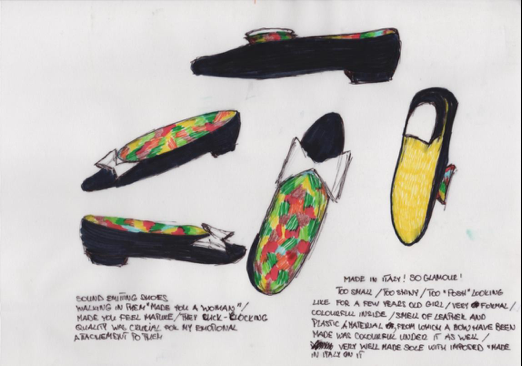
In feedback students reported that, as they drew the images they progressively recalled more information about the shoes, the act of drawing provided the retrieval cues that helped build more substantive and clear memories of the shoes.
In this workshop students were seated in rows facing each other. Following a 1 minute period of observation, they were asked to draw a 5 minute portrait of the person opposite. On completion they turned away from the subject, and drew a second picture of the subject from memory. Each person drew all members of the group. Feedback from this workshop described how students had memorised ratios and proportions to recall the distances between features and accumulated relevant information with each additional portrait. Participants reported an improvement in their ability to recall through repetition and heightened levels of focused concentration.
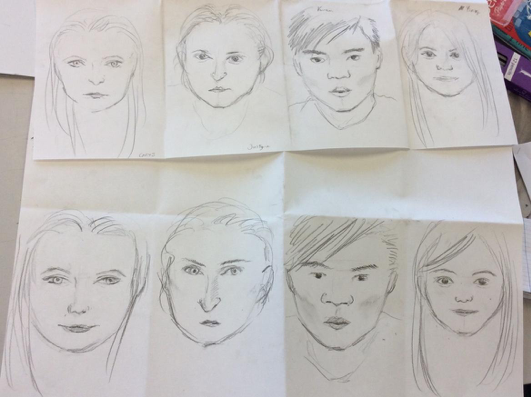
As these workshops reveal, memory training can focus and engage participants’ abilities to record and recall information. Drawing Lab was a collaborative learning experience. Students began to discuss their practices and share experiences openly outside the curriculum. Findings so far indicate that the co-curricular workshop approach, can be employed across disciplines, across levels of ability and throughout arts and design education. Feedback from students indicates that these activities support them to develop techniques for achieving higher levels of concentration, leading to enhancements in memory, imagination, intelligence, and feeling.
Over the course of the five workshops students became increasingly aware of the relationship between sensory retrieval cues and other techniques for retrieving stored information. Aspects of memory training and use of mnemonic devices can be applied by participants as a tool for generating new creative content or insightful creative approaches to project work.
When exploring shared experiences everyone has a unique perspective, coloured by their individual absorption or encoding mechanisms. In terms of memory storage, though we hear, see and feel many things, we do not remember all of them. As seen in the Memory Recall workshops, drawing can allow us to access autobiographical and episodic memory in order to substantiate stored information.
Design courses encourage students to move towards continuously refined, considered and theoretical approaches to problem solving through employing techniques such as design thinking. It is valuable then to explore ways to maximize and expand upon the ability to encode and store information. Drawing is an innate human ability. It can serve as a mechanism for observing and measuring the act of remembering, when used to make sense of the world it may help us to engage with and register reality.
If digital mass storage devices can assist with information storage, further means and methods for utilizing and enhancing human forms of encoding should be valued as they are able to express experience. Visualization and exploration through drawing, aim to decipher experience. Acting as a form of recording mechanism, each drawing, as an instance of memory, retains an element of self. This is in contrast to visual records from mobile phones and other snapshots or movies, which store the record of a moment frozen in time but do not contain the subtle nuances provided by exploration and analysis of the physical sensory experience.
Drawing appears to have become an undervalued tool in the art school curriculum, yet it plays a valuable role in encoding and distilling visual experience and transforming it into a concrete and substantive form. A continuation of co-curricular collaborative projects such as Drawing Lab could assist students and enhance learning and teaching in Art and Design through rethinking the purposes of drawing, seeing it as a capture mechanism, storage device and a tool for exploring communication.
Baddeley, A. (2000) ‘The episodic buffer: a new component of working memory?’, Trends in Cognitive Sciences, 4(11), pp.417–423. https://doi.org/10.1016/S1364-6613(00)01538-2.
Berger, J. (2012) Berger on drawing. Edited by J. Savage. Aghabullogue, Ireland: Occasional Press.
Corey, S.M. (1954) ‘Action research in education’, The Journal of Educational Research, 47(5), pp.375-380. https://dx.doi.org/: 10.1080/00220671.1954.10882121
Cross, N. (1990) ‘The nature and nurture of design ability’, Design Studies, 11(3), pp.127–140. https://dx.doi.org/10.1016/0142-694X(90)90002-T.
de Boisbaudran, L. (2011) The training of the memory in art and the education of the artist. Translated by Luard, L. New York: Waldo Specthrie Press.
Drawing Lab (2015) Drawing Lab: Exploring memory making through drawing, November. Available at: http://memorydrawing.tumblr.com/ (Accessed: 9 August 2018).
Holland A.C. and Kensinger, E.A. (2010) ‘Emotion and autobiographical memory’, Physics of Life Reviews, 7(1), pp.88–131. https://dx.doi.org/10.1016/j.plrev.2010.01.006.
Ingold, T. (2011) Being alive: Essays on movement, knowledge and description. Abingdon: Taylor and Francis.
Levi, P. (1989) The drowned and the saved. London: Abacus Books.
Lydall, R. (2013) ‘Marr: Drawing gave me back my life, so why don't we still teach it?’, Evening Standard, 1 Nov. Available at: https://www.questia.com/newspaper/1G1-347689021/marr-drawing-gave-me-back-my-life-so-why-don-t-we (Accessed: 9 August 2018).
Stahl, S.M., Davis, R.L, Kim, D.H. et al (2010) ‘Play it again: The master Psychopharmacology Program as an Example of Interval Learning in Bite-Sized Portions’, CNS Spectrums, 15(8), pp.491-504. https://doi.org/10.1017/S1092852900000444
Tulving, E. and Thomson, D.M. (1973) ‘Encoding specificity and retrieval processes in episodic memory’, Psychological Review, 80(5), pp.352–373. http://dx.doi.org/10.1037/h0020071.
Tversky, B. (2011) ‘Visualising thought’, Cognitive Science, 3(3), pp.499–535. https://dx.doi.org/10.1111/j.1756-8765.2010.01113.x.
Wammes, J.D., Meade, M.E. and Fernandes, M.A. (2016) ‘The drawing effect: Evidence for reliable and robust memory benefits in free recall’, The Quarterly Journal of Experimental Psychology, 69(9), pp.1752–1776. https://dx.doi.org/10.1080/17470218.2015.1094494.
Wells, P. and Quinn, P. (2008) Drawing basics 03: Drawing for animation. Lausanne: AVA Publishing.
Michelle Salamon is acting Platform Leader in Time and Movement on BA (Hons) Graphic Communication Design and an Associate Lecturer in MA Narrative Environments at Central Saint Martins. She presented a paper on ‘Memory and Animation’ at the Animated Realities conference held at Edinburgh University School of Art in 2011 and ran a workshop on ‘Memory Drawing’ at the Thinking Through Drawing We All Draw symposium in 2015.